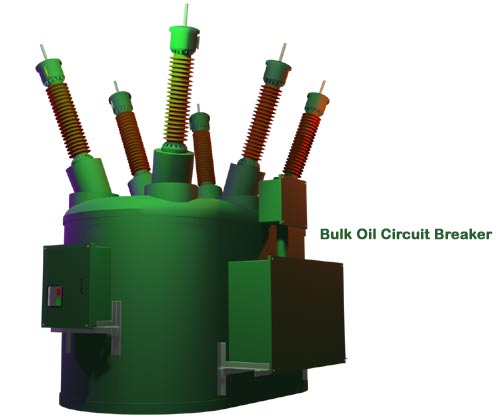In the early days, less 1910 or the early 20th century, most utilities used a bulk oil circuit breaker (BOCB) for high-voltage switching during that time.
Earlier air circuit breakers served the purpose of switching high voltage and very high voltage current. But after the 19th century, engineers realized that mineral oil, or specially treated mineral oil, could perform arc quenching more efficiently than air in high-voltage systems. Arc quenching efficiently without creating high switching overvoltage was the main challenge.
Oil has two benefits when used in a circuit breaker.
- If the contacts open in the oil, the arc forms due to the high voltage gradient between the contacts. The high temperature of the arc vaporizes and decomposes the oil, producing hydrogen gas. This hydrogen gas is a very good coolant medium and facilitates easy arc quenching.
- Mineral oil is a very good insulation medium. It can quickly re-establish dielectric strength between the contacts after arc quenching and also provide insulation between the live contacts and the tank of the bulk oil circuit breaker.
Construction of a Bulk Oil Circuit Breaker (BOCB)
A bulk oil circuit breaker is normally a dead tank-type circuit breaker. The entire contact assembly is immersed in a large steel or GI tank filled with insulating oil. The same oil serves two purposes: arc quenching and insulation. That’s why we call it a bulk oil circuit breaker.

Working Principle of a Bulk Oil Circuit Breaker
During the closed position of the contacts, normal current flows through the contact assembly. The oil electrically insulates the live parts of the contacts from the outer tank of the breaker.
During a fault, the relay detects it and sends a trip signal to the circuit breaker tripping mechanism. This initiates the opening of the breaker; the moving contact separates from the fixed contact, creating a physical gap. An arc forms between them. Initially, oil surrounds the arc. But the high temperature (~1000°C) vaporizes and decomposes the oil, creating high-pressure hydrogen gas.
The enclosed surrounding oil pressurizes the gas because. Hydrogen’s excellent cooling property rapidly removes heat from the arc, while the generated hydrogen gas and oil vapor displace and deionize the arc path. At the next natural current zero (which occurs 100 times per second at 50 Hz), the arc extinguishes. The temperature drops quickly, fresh cool oil rushes into the contact gap, and restores the dielectric strength, preventing restriking of the arc.

Disadvantages of BOCBs
Although an excellent arc-quenching option compared to large air-blast circuit breakers of the time, bulk oil circuit breakers have drawbacks:
- Require a large quantity of oil, often over 100 liters, increasing with voltage rating, which increases size and weight. Above 132 kV, they become exceptionally large.
- Fire hazard due to explosive gases from oil decomposition, which can ignite.
- High maintenance needs — arcing decomposes and carbonizes the oil, requiring periodic filtering and replacement.
- Oil leakage can contaminate soil and groundwater.
- Slower opening and closing speed than modern breakers.
- Large size and heavy weight require strong support and bigger foundations.
Bulk oil circuit breakers were a huge step forward in early power system protection. They use mineral oil for both arc quenching and insulation, but demand frequent maintenance and oil replacement, and pose fire hazards. Therefore, engineers developed the minimum oil circuit breaker, which will be discussed in the next article.
